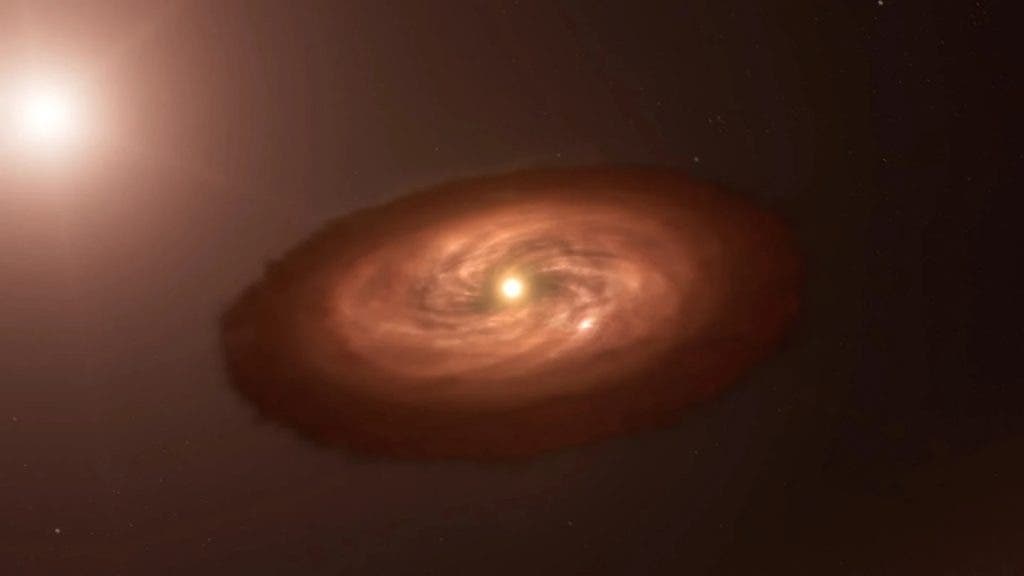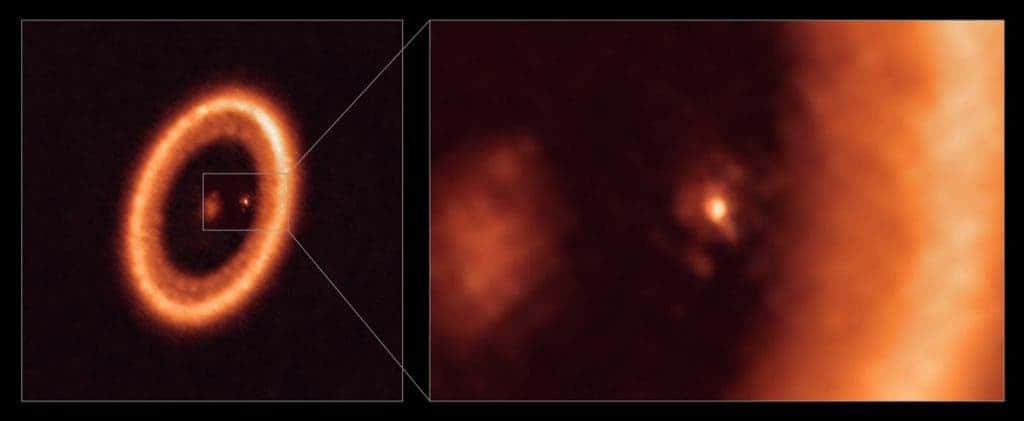
In the early 1990s, scientists knew about a handful of exoplanets (planets outside the solar system). Since then, more than 4,000 exoplanets have been confirmed with thousands more up for investigation. Indeed, technology and astronomers’ skills have grown tremendously. So much so that we can now peer inside certain exoplanets and determine their composition or atmosphere, as well as tell whether some have moons orbiting them. Now, astronomers have upped their game once more, reporting the discovery of a disk of gas and matter surrounding a planet that is supposed to coalesce into a new moon.
The novel discovery was made in the PDS70 star system, located relatively closeby, about 370 light-years from Earth in the constellation Centaurus. Astronomers working with the European Southern Observatory’s (ESO) Atacama Large Millimeter/submillimeter Array (ALMA) found that the system consists of at least two huge Jupiter-sized planets, along with a dust-rich circumstellar disk about as large in width as the distance from the Sun to Earth’s orbit.
Both gas giants feed on the dust disk, funneling material towards them by gravity. So, essentially, these young planets, unceremoniously named PDS 70b and PDS 70c, are still a work in progress.
“More than 4,000 exoplanets have been found until now, but all of them were detected in mature systems,” says Miriam Keppler, co-author of the new study and researcher at the Max Planck Institute for Astronomy in Germany. “PDS 70b and PDS 70c, which form a system reminiscent of the Jupiter-Saturn pair, are the only two exoplanets detected so far that are still in the process of being formed.”

This image shows wide (left) and close-up (right) views of the moon-forming disk surrounding PDS 70c, a young Jupiter-like planet nearly 400 light-years away. The close-up view shows PDS 70c and its circumplanetary disk center-front, with the larger circumstellar ring-like disk taking up most of the right-hand side of the image. Credit: ALMA (ESO/NAOJ/NRAO)/Benisty et al.
But the researchers noticed something else too. When they zoomed in on the high-resolution observations in submillimeter light performed by ALMA, the astronomers uncovered a circumplanetary disk surrounding PDS 70c. The disk was so well defined that its size could be ascertained, being roughly 500 times larger than Saturn’s rings.
This moon-making disk is most likely made of the same material as the much larger looming circumstellar disk that was collected by PDS 70c as the planet swept its orbit. Over millions of years, the researchers believe all of this matter will join together to form a new satellite, similar to how planets form around the sun from the much larger circumstellar disk. In fact, there may be enough material to make three satellites the size of Earth’s Moon.
Subsequent observations should serve to confirm that the object in question around PDS 70c is indeed a circumplanetary disk. If that’s the case, these observations could prove invaluable in clarifying how exomoons form and validating existing theories concerning their formation. ESO’s Extremely Large Telescope (ELT), currently under construction on Cerro Armazones in the Chilean Atacama desert, will be ideal for this task.
“The ELT will be key for this research since, with its much higher resolution, we will be able to map the system in great detail,” says co-author Richard Teague, a co-author and Submillimeter Array (SMA) fellow at the CfA.
The findings were reported in The Astrophysical Journal Letters.


